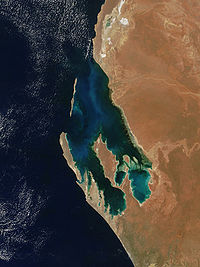
Photo from wikipedia
Understanding the connectivity of exploited fish populations is critical to their management under both rapid and long-term environmental change. Patterns of connectivity are unknown for most fishes in the Shark… Click to show full abstract
Understanding the connectivity of exploited fish populations is critical to their management under both rapid and long-term environmental change. Patterns of connectivity are unknown for most fishes in the Shark Bay World Heritage Area (Western Australia), a large, shallow embayment in the eastern Indian Ocean, vulnerable to marine heatwaves. The composition of oxygen (δ18O) and carbon (δ13C) stable isotopes in whole otoliths of the recreationally-important reef fish Lethrinus laticaudis did not differ between Shark Bay's two large inner gulfs, separated by the Peron Peninsula. However, significant differences were found between pairs of locations with different salinities over a spatial scale of ∼60 km within each gulf. Misclassification of samples was greatest between locations mostly in different gulfs, but with similar salinities (15-41%), and rare between adjacent locations in the same gulf with different salinities (0-5%). This is influenced by the strong correlation (ρ = 0.93) between δ18O in otoliths and the salinity gradient of the two gulfs, and further supported by a lack of correlation in the similarities of isotope compositions and distances between locations (ρ = 0.16). Fish samples from each of the different locations were composed of multiple year-classes, yet the otolith chemistry distinguished them at a minimum distance of 16 km apart, indicating that small-scale connectivity of L. laticaudis is likely during the majority of their life cycle. Physical barriers to movement of post-settlement individuals (land masses, expansive seagrass and sand) between the small, isolated reefs of Shark Bay may reduce large scale connectivity, which instead would occur mostly by egg and larval dispersal. The probable scale of connectivity of post-settlement L. laticaudis indicates that this major recreational fishing target species may be vulnerable to localised over-exploitation and negative environmental effects on population sources and sinks within this shallow embayment. Maintaining sustainable spawning biomass at scales relevant to the extent of connectivity for such a species in a World Heritage Area is an important management consideration.
Journal Title: Marine environmental research
Year Published: 2021
Link to full text (if available)
Share on Social Media: Sign Up to like & get
recommendations!